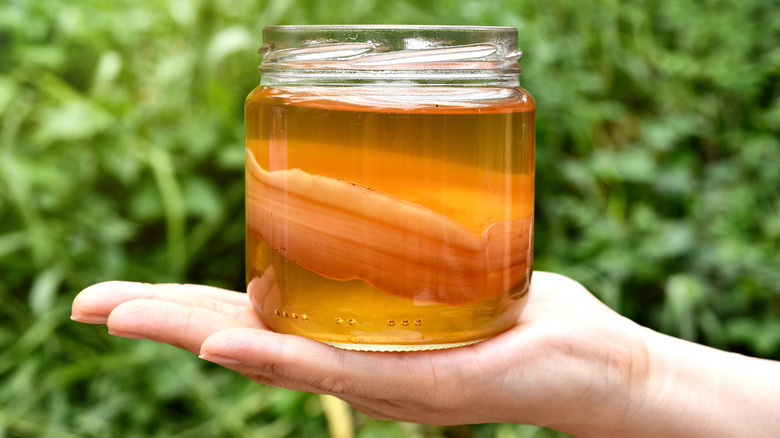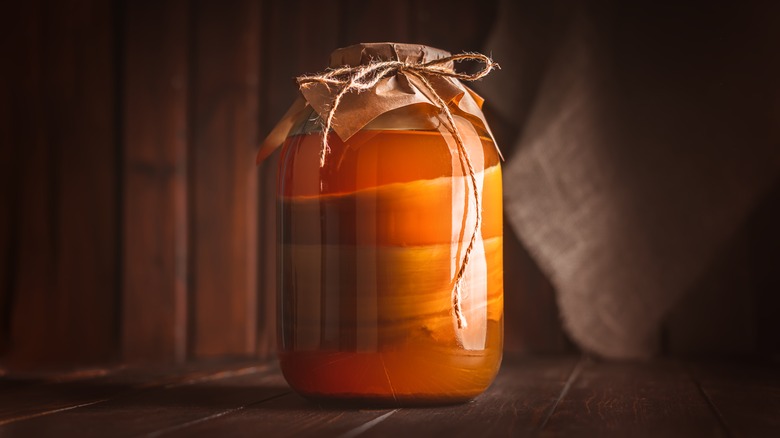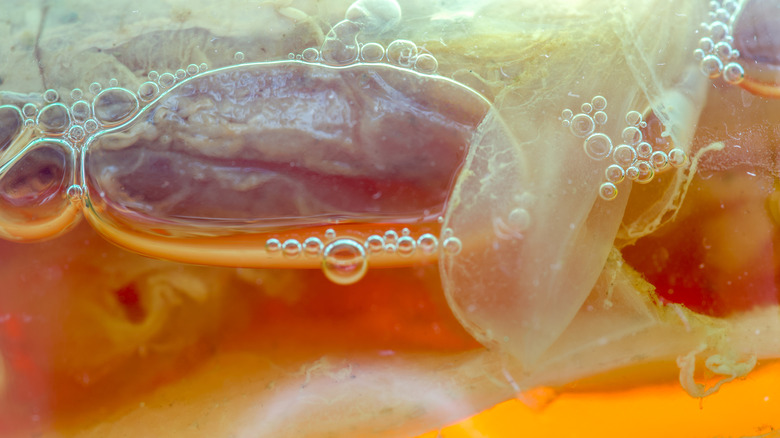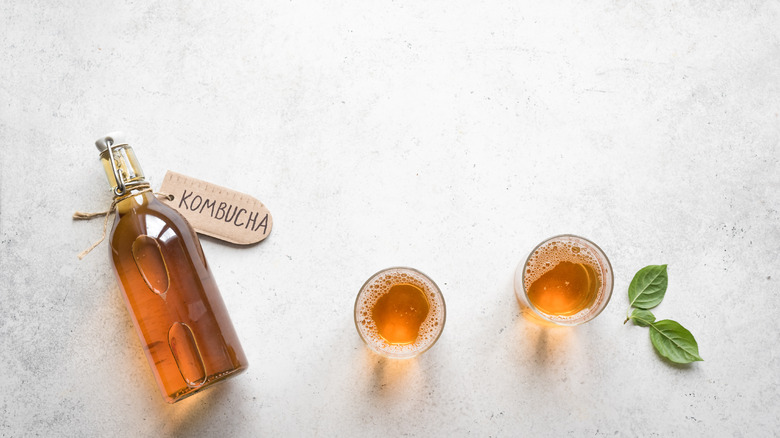The Grassroots Way Kombucha Came To The US
With a rapidly increasing variety of kombucha brands lining the grocery aisles, it's no wonder so many fashionable consumers reach for a bottle of kombucha every day. But where did its fashionable and hippie reputation come from?
Kombucha's initial popularity in the United States happened during the mid-1960s, and the period is likely responsible for kombucha's enduring bohemian connotation. In a 2013 article, NPR called kombucha a "product of health food stores and hippies' kitchens," and a 2017 Independent article called, "The Hippies Have Won," lamented, "Kombucha was something your art teacher might have made in her basement." Kombucha was even ranked as the most liberal product in America in 2009 by Slate.
It seems despite reaching widespread popularity and consumption, kombucha may never fully shake its hippie roots. But, there's more to kombucha than just a $4 bottle of a tangy beverage in earth-toned packaging. Kombucha has a long history filled with medicinal ideologies and cultural movements as bubbly as the fermented tea itself.
The origin of kombucha
Although kombucha's origins are a little uncertain, some claims put its start in China as early as 221 B.C.E., over 2,000 years ago, according to World Kombucha Day. (For the record, World Kombucha Day is now an internationally-recognized holiday on February 21. The date, 2/21, is an homage to the year of earliest recorded evidence of kombucha, 221.) It's rumored that Emperor Quin Shui Huang, pursuing eternal life, commissioned kombucha as a longevity elixir, per Revolution Fermentation.
From there, the kombucha fever spread. It's probable that kombucha gained popularity and scope via the Silk Road, a network of trade routes connecting China and the Far East with the Middle East and Europe, per History. It was established during the Han Dynasty, which ruled China (and its trade) from 206 B.C.E. to 220 A.D, ending just one year prior to the earliest record of the fermented tea.
Kombucha made its way to Europe in the 1950s, according to the Smithsonian. Italian parishioners, it says, were even reportedly mixing it in their holy water to amplify its healing properties.
Kombucha hits the US
It took a lot longer for kombucha to reach the United States. The first notable American Kombucha Renaissance happened after World War II. Rations made sugar a scarce resource (per the National WWII Museum) driving any fledgling kombucha fans into non-existence, according to Equinox Kombucha. Made from a combination of sweet tea and SCOBY or a "symbiotic culture of bacteria and yeast" that aids the fermentation process (via Healthline), sugar is integral to the process. According to Brew Dr. Kombucha, the sugar from the sweet tea feeds the SCOBY, which causes cloudy masses of beneficial bacteria to grow. Without public access to sugar, the kombucha train temporarily derailed.
During the 1960s, kombucha made a comeback. The grooviest households, particularly in California, began brewing their own fermented tea as a fashion-forward DIY drink, reports Equinox Kombucha. Kombucha spread as a medicinal and cultural phenomenon as enthusiasts began sharing their SCOBYs with one another, so more and more homebrewers could make their own, according to Forbes.
The fashionable revival of personal health during the '60s aided in kombucha's rapidly-increasing popularity. Interest in yoga, meditation, Eastern spirituality, and the value of nature were all popularized in the West during the '60s, reports HuffPost.
Kombucha's continuing legacy
The tea saw another revival during the HIV/AIDS epidemic of the late 1980s, via Britannica, as rumors surfaced that kombucha could increase T-Cell counts and boost immune health. In a 1994 Los Angeles Times article, Dr. Gary Cohan of the Pacific Oaks Medical Group, which specializes in HIV/AIDS treatment and research, told the paper that between 15% to 20% of his AIDS patients had tried kombucha as a holistic cure.
Everything changed when kombucha went public. In 1994, Norman Baker and Betsy Pryor established Laurel Farms, a kombucha distribution outlet in California. Laurel Farms quickly became the most well-known kombucha cultivator in America, mailing their product in monthly shipments. Healthy customers were charged $50 and chronically ill patients were charged $15, according to a 1995 write-up in the Baltimore Sun.
Kombucha started becoming more widespread when GT's Synergy Raw Kombucha (started by owner GT Dave) hit the market in 1995. After acquiring a Himalayan Mother SCOBY in the early '90s, GT Dave began manufacturing his own small batches of kombucha in his home kitchen, via Vox. Today, Synergy is the country's top-selling kombucha company, estimated to be worth over $900 million in 2020, reports CNBC.
For a fermented tea with a grassroots start, kombucha isn't going anywhere any time soon. According to Global Newswire, the global kombucha market is estimated to be worth about $2,086 million in 2022 and is forecasted to reach $6,137 million by 2028.



